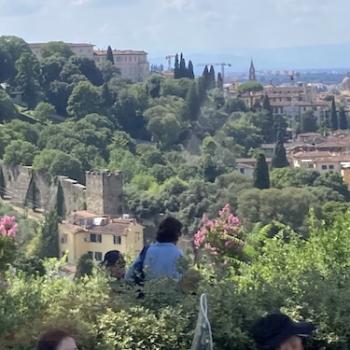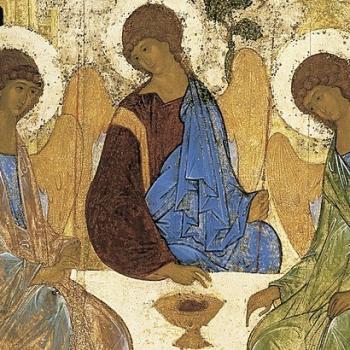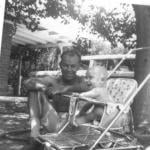The Burning Bush
There is a burning bush at the heart of all things, Maximus says. (I’m reading “Difficulty 10” again.).
If we don’t turn aside to see it, we will walk by and never meet the God who came looking for us in this moment. The good news is that the very next moment offers another invitation.
The one who contemplates God, Maximus tells us, unites within herself the two realms, the intelligible and the sensible. Or let’s say the fire and the bush. The leaves and branches of the material world remain: they do not burn up. And yet the fire is there, it’s real, and the voice of God calls to us out of it.
Contemplation of a Child
If you were with Maximus and me for morning coffee, you read the five stages of contemplation. Maximus tells us that we can come to the divine fire at the center of anything around us, anything in the world of scripture or nature. We do so by sitting with it in a moment of contemplative listening.
Contemplation is the path to theosis, or kinship with God. We live into kinship with God by being more, not less, connected to the human world.

This morning I will contemplate the burning bush that is my younger daughter. Any child’s caregiver will know the difficulty of staying present for the tantrums, the bad dreams, the tears, and the teenage sarcasm. If Maximus had written a book on parenting, he would have called these “Difficulties 1-100.”
Maximus reminds me that my calling to parenthood is not other than my calling to discipleship. My daughter is my path to theosis.
Stage 1: Being
This child was born into the world by a series of causes I can trace. But even this is obscure and mysterious, as any explosion of life into existence is. I understand the biology, but I cannot avoid the mystery. God is the mysterious cause of all that mystery. I cannot say what God is like, at this stage. I can only sit in awe that there is being rather than nothing. And the evidence is right there before me: once there was no child, and now she is.
The theological tradition, following Aristotle, gives us a richer language of causality than we normally traffic in. A cause can “push” from behind, like a cue ball on a pool table. But it can also “pull” or beckon us, like a magnet. God is the cause that bumped my daughter into being; but God is also the cause that invited a world to give birth to her. “Let there be that child,” God says. And the rich, complex, evolving world obliged.
Stage 2: Motion
My daughter is always in motion, so this one seems easy. Building, inventing, dispensing Scotch tape. Singing into a voice-changer microphone. But this moment of contemplation is not just about what caused all that motion. It’s about who all that motion reveals God to be. God considered the idea of a human being whose thought world would burst at the vision of a roll of unused tape, and God called that being into existence. This is the God who made whales for sport, as the Psalm says. Watching her, I learn something of the playful joy of God. The idea of this child was too good: God just had to make her.
Stage 3: Difference
What is unique about her? This is also obvious. Her voice, her fascinations. The way in which the next thing she says could only come from her. Yet the better I know her, the more I suspect that there are depths there that I can’t reach. And this is just as true for the five year-old who wants to show me everything as it is for the 15 year-old who will—if previous experience holds true—prefer to lock herself in her room. If the “motion” stage observes the beginning of her creation, when God providentially brought her into being, this stage observes the divine response. This is when God passes judgment on what God has made. God looks at the explosion of difference that she brings into the world, and God loves it. God see her completely, and God says “She is good.”
Stage 4: Mixture
This is where I begin to notice what happens to me as I approach this particular burning bush. Perhaps Moses at first was thinking only of his work, tending the sheep. That’s me, anyhow. I generally begin from distraction. The budget to balance, the dinner to prepare. But those moments that my daughter calls me out of myself are what my counselor wife calls GEMs: genuine encounter moments. The sudden experience of connection. Laughing or crying together, loving a movie or book together. Playing Polly Pockets. A 3AM conversation about a nightmare. My initial distraction or annoyance shifts into hospitality for the being of another. My prejudicial assumption of scarcity—not enough time, not enough of me for you at this moment—becomes a joyful experience of plenty. God has made enough time. And God has made enough of me.
Stage 5: Place
And now I get to pass a moment in gratitude for the place God has given me in creation. I have the gift of discovering who I am as I discover who my child is. Left to myself, I would wander over the Midian mountaintop and never suspect that God was waiting for me here. With her, I have learned something of God’s mysterious joy, God’s perfect judgment. And further, I have learned how God wants to reveal Godself in me. I am now celebrating the way that my daughter calls me to be a bit more like God. She is my path to theosis, if I can take a moment to notice her.











